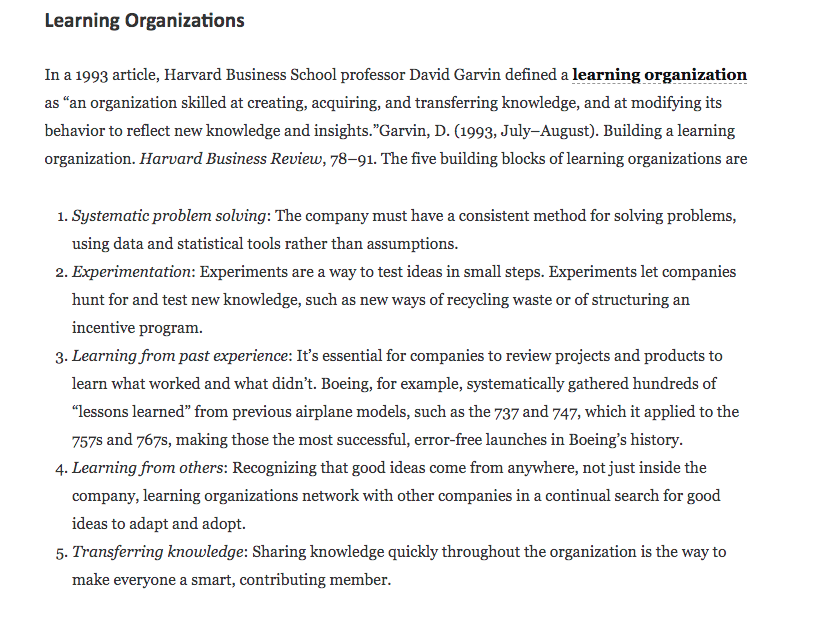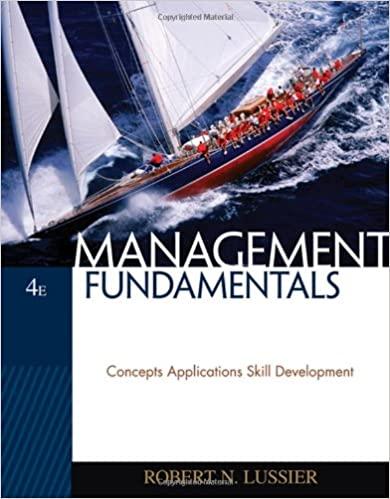Question
Globalization is an emerging force in business today. Read the case study about Globalization and The Coca-Cola Company locatedin the Reading Assignment In Section 3.4,
Globalization is an emerging force in business today. Read the case study about "Globalization and The Coca-Cola Company" locatedin the Reading Assignment
In Section 3.4, the text discusses the "Top 5 Challenge Trends" and "Top 5 Solution Trends." Select one challenge and one solution trend which you believe is most applicable to Coke's situation today. Describe how these trends apply to Coke. In Section 3.3 ( https://2012books.lardbucket.org/books/management-principles-v1.1/s07-04-global-trends.html ) , read about the five building blocks of a Learning Organization. Which one of the five building blocks should Coke focus on to capitalize on the trends you selected. Why?
A significant and considerable answer is required
Globalization and The Coca-Cola Company Introduction Today, Coca-Cola is one of most recognizable brands in the world. This company has continued to gain momentum and growth in recent years by capitalizing on the rapidly expanding global beverage industry. With its push for an increased global market share, Coca-Cola now operates in over 200 countries with over 84,000 suppliers. Presently, over 70% of Coca Cola's business income is generated from non-US sources (CocaCola Company, 2012). In just a little over a century, Coca-Cola has grown into a multibillion dollar business. In spite of its tremendous financial and marketing achievements, the road to success has not always been an easy one for Coca-Cola. Some countries have banned or heavily restricted the sale of their products, claiming that some of Coke's staple soft drinks are "threatening public health" and "encouraging obesity." Multiple lawsuits alleging labor violations have also been lodged against Coca-Cola with accusations pertaining to "child labor sweatshops" and "the denial of health care benefits to workers based on various forms of discrimination." In addition, the beverage industry has witnessed a flood of new competitors introducing alternatives to main stream soda brands. Coca-Cola has responded by introducing new beverage brands of its own including Sprite, Fanta, Minute Maid, Simply Orange, Fresca, Vitamin Water, Smart Water, Odwalla, and Powerade. In light of the obstacles Coca-Cola has overcome, the company has remained true to its commitment to provide quality, refreshing, and satisfying products to consumers. In order to ensure each product maintains a high level of quality regardless of purchase location, Coca-Cola continues to keep its beverage recipes secret with tightly controlled manufacturing facilities located throughout the globe. Coca-Cola has never lost sight of its goal to be the largest and most successful beverage company in the world. Let us take a closer look at Coca Cola's journey into the global market. Coca-Cola's Journey to Globalization Founded in 1892, Coca-Cola was developed by John Pemberton, a small town pharmacist who was confident that quality and consistency would lead his company to the forefront of global soda supply. Around that same time, storekeepers began to shift their inventories towards increasingly popular pre-packaged products that relied heavily on brand name recognition. Coca-Cola met and exceeded these consumer demands by crafting its iconic red and white logo and carrying out a vigorous marketing campaign throughout the United States. Saylor URL: www.saylor.org/bus208 The Saylor Foundation Saylor.org Page 2 of 4 During the early 1900's, Coca-Cola began a modest expansion into the global market. Bottling plants were initially built in Cuba and Panama as the US military expanded into the region. Locals soon found themselves enamored with Coca-Cola, which led to a sharp increase in demand for the sugary drink. These plants proved quite successful, reducing much of the shipping and delivery costs typical of foreign distribution operations. Additional bottling plants soon followed in Hawaii, Puerto Rico, Guam, and the Philippines. These regional successes formed the impetus for launching a global market testing campaign which allowed Coca-Cola to sample their wares in various countries throughout the world. By 1926, Coca-Cola had established foreign relationships and bottling plants located around the world supported by its Center of Global Operations. World War II and the Cold War marked the signature period in which Coca-Cola was able to establish itself as a true global corporation known for its efficiency and worldwide capabilities. The company continued to expand throughout the late 20th and early 21st centuries, arguably becoming one of the world's most iconic brands. Next, let us take a look at three key strategies employed by Coca-Cola to support rapid growth and expansion across the globe: global marketing strategies, product differentiation, and technology. Global Marketing Strategies Coca-Cola's marketing strategies played a significant role in successfully globalizing the company. Their popular advertising slogans and catchy jingles played into the hearts and minds of people around the world. Some of their best advertising slogans include: ? "Drink Coca-Cola." ? "Things go better with Coke." ? "Good 'til the last drop." ? "It's the real thing." ? "Always Coca-Cola." ? "Enjoy." ? "Life tastes good." One of the company's most popular jingles was known as "I want to buy the world a coke," produced in 1971 by Billy Davis. The commercial featuring this song portrayed a Saylor URL: www.saylor.org/bus208 The Saylor Foundation Saylor.org Page 3 of 4 world of hope and love produced by a group of multicultural teenagers on top of a hill. This commercial has gone down in history as one of the most well-known commercials of all time. Coca-Cola was the first commercial sponsor of the Olympic Games in Amsterdam in 1928 and has regularly sponsored the event for over 80 years. They also sponsor many other sporting events such as the International Federation of Association Football (FIFA), National Hockey League (NHL), National Basketball Association (NBA), National Football Association (NFL), Major League Baseball (MLB), NASCAR, and the Cricket World Cup. Product Differentiation Another key factor that has supported Coca-Cola's globalized vision has been the company's ability to customize its product line to meet the needs of individual consumer markets. For example, Coca-Cola has appealed to younger consumers by offering Powerade, energy drinks, and a variety of flavored Coke products, such as Cherry Coke and Vanilla Coke. The company is also meeting the needs of the health conscious, older consumer with Diet Coke, Vitamin Water, and Odwalla products. Coca-Cola has invested significant time and money into researching and understanding different marketing trends and consumer segments based on lifestyle, age, and income in order to accurately develop and market its products. Packaging differentiation has also played a key role in how adaptable the Coca-Cola product line is to various market segments. Functional packaging has been used to make the products available in different sizes and forms, including glass and plastic bottles, aluminum cans, and fountain drink dispensers. The company takes great care in choosing the various shapes and sizes of the bottles and cans to ensure easy stacking and vending machine dispensing, and to allow for health conscious consumers to limit their intake. To promote the company's commitment to environmental sustainability, all packaging materials are designed to be recyclable and labeled accordingly for easy consumer identification. Technology Technological advances contributed to Coca-Cola's ability to globalize rapidly throughout the 20th century. Product transportation became more efficient and cost effective with the development of bigger and faster semi-trucks, cargo ships, jet aircraft, and trains. Coca-Cola was able to manufacture and ship products quicker and farther to market segments that were unreachable before these transportation improvements. Advances also allowed distributors and warehouses to more accurately track inventory levels and fill order shipments, resulting in lower overall operating costs. Computerized and automated manufacturing equipment increased the speed and volume in which Saylor URL: www.saylor.org/bus208 The Saylor Foundation Saylor.org Page 4 of 4 products were produced. These technological advances enabled Coca Cola to compete on a global scale, selling the well-known brand of products across the world at highly competitive prices. Summary ? Coca-Cola is one of the most well-known brands in the world, operating in over 200 countries. ? While the global marketplace has presented numerous opportunities for CocaCola, the company has also encountered global attacks on the nutritional value of its products as well as numerous accusations of unfair labor practices. ? Coca-Cola's iconic logo, brand recognition, convenient packaging, and consistent product manufacturing has solidified its reputation and allowed the company to gain the lion's share of global market shares. ? A pioneer in globalization, Coca-Cola began expanding its bottling and manufacturing facilities back in the early 1900's, establishing key foreign partnerships. ? Coca-Cola's marketing strategies, including memorable advertising slogans, catchy jingles, and sporting event sponsorships, played a significant role in winning over the hearts and minds of global consumers. ? Product differentiation, such as offering different beverages in flexible packaging options, allowed Coca-Cola to customize the product for different market segments. ? Technology advances, including product transportation, telecommunication, and computerization, became the driving force behind Coca-Cola's ability to capitalize on rapidly expanding markets. References Coca-Cola Company (2012). Wikinvest. Retrieved December 11, 2012. http://www.wikinvest.com/stock/Coca-Cola_Company_(KO)

Step by Step Solution
There are 3 Steps involved in it
Step: 1

Get Instant Access to Expert-Tailored Solutions
See step-by-step solutions with expert insights and AI powered tools for academic success
Step: 2

Step: 3

Ace Your Homework with AI
Get the answers you need in no time with our AI-driven, step-by-step assistance
Get Started


